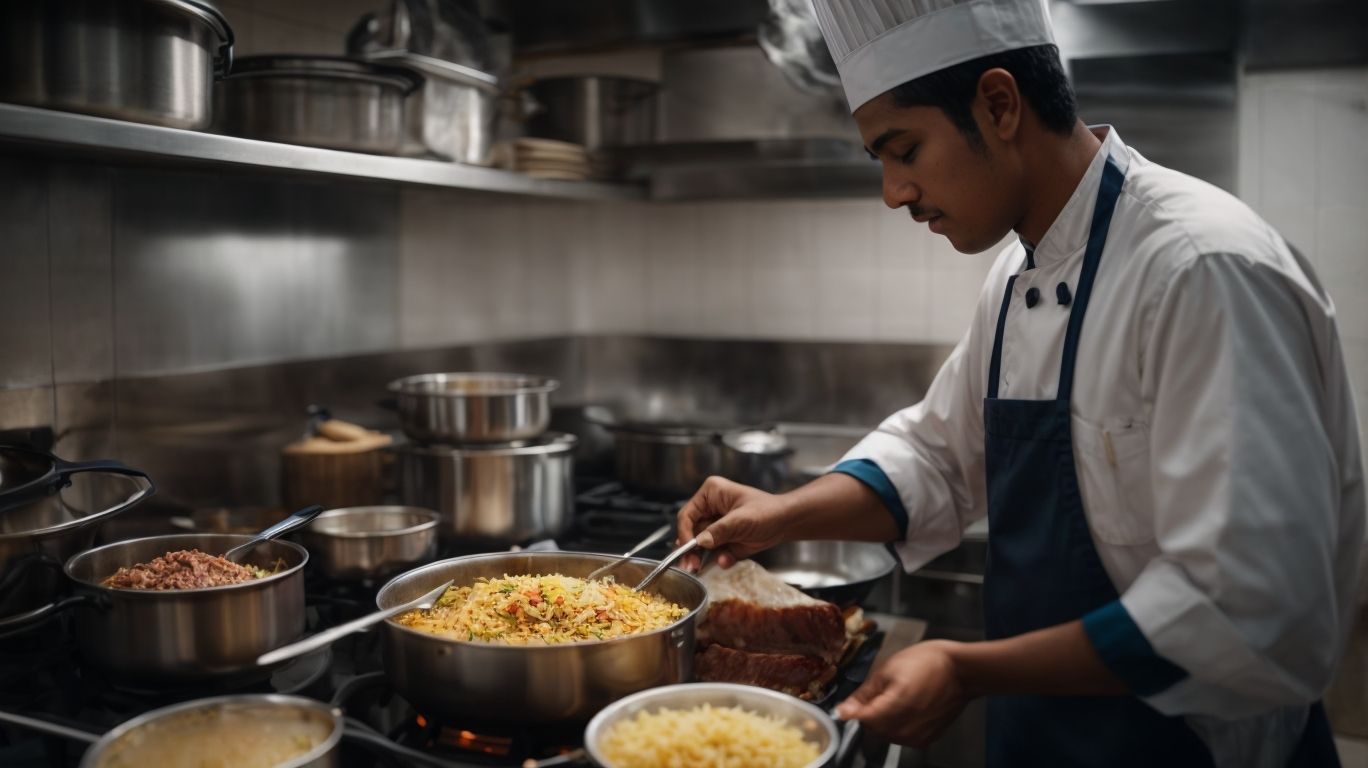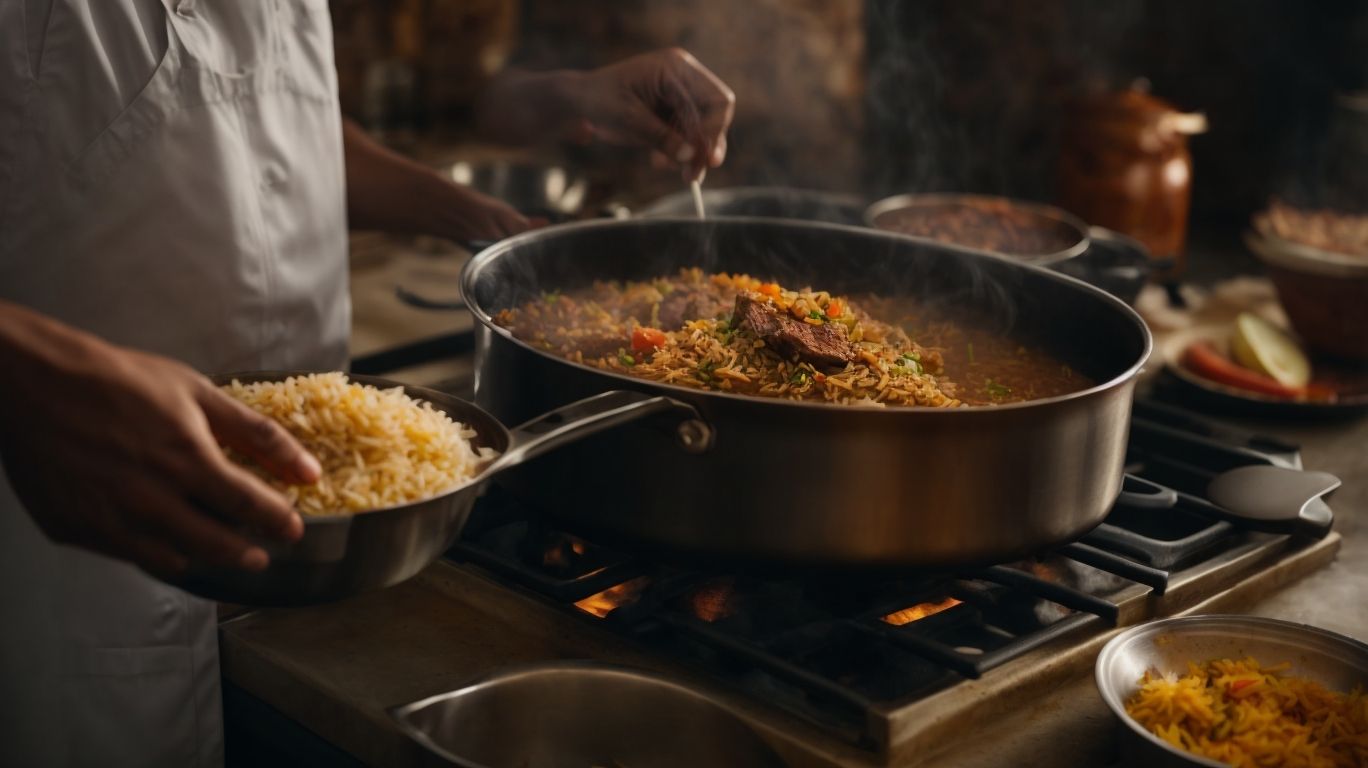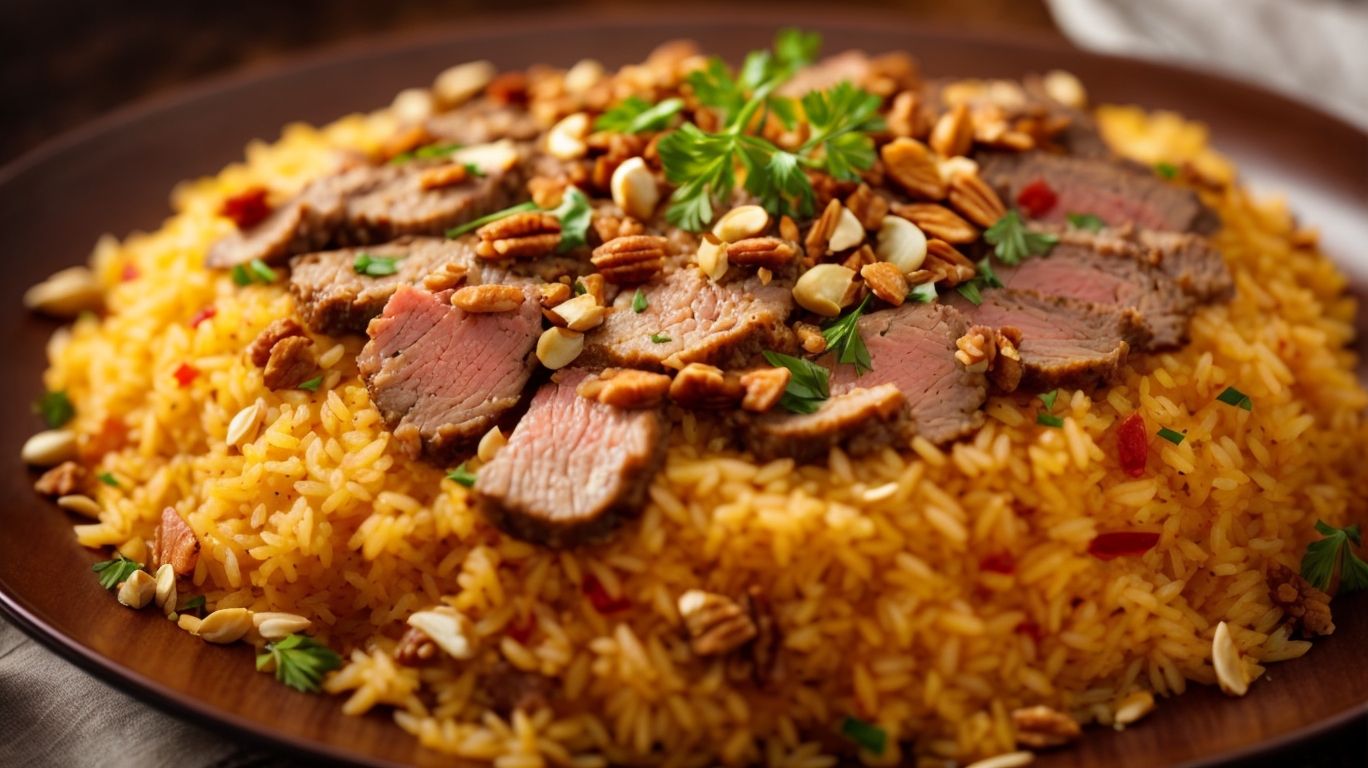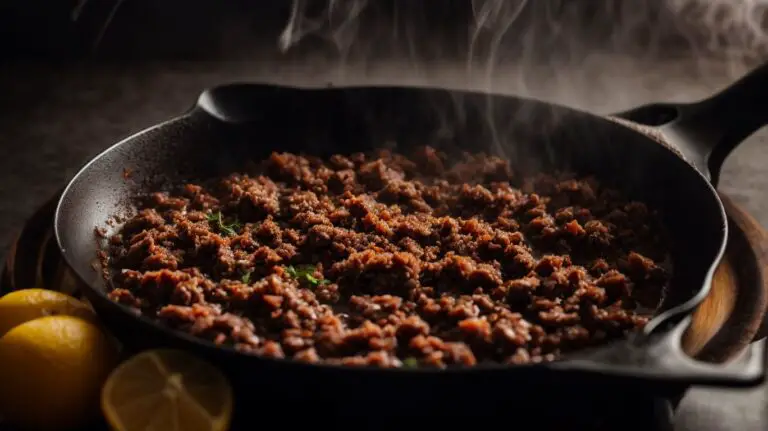How to Cook Kabsa Rice With Meat?
Are you looking to spice up your dinner routine with a delicious and flavorful dish? Look no further!
In this article, we will be exploring the mouthwatering world of Kabsa Rice with Meat. Join me, Chris Poormet, as I guide you through the ingredients, preparation, cooking, serving, and variations of this traditional Middle Eastern dish.
Get ready to tantalize your taste buds and impress your family and friends with this incredible recipe!
Key Takeaways:
About the Author: Chris Poormet

Credits: Poormet.Com – Zachary Carter
Meet Chris Poormet, the talented owner of Poormet.com, a renowned blog that showcases a delightful array of recipes and culinary tips. Chris’s exceptional culinary skills have earned him the prestigious title of ‘Culinary Blogger of the Year’, reflecting his expertise as a former chef and accolades in food photography.
His journey as a chef began in his small hometown, where he discovered his love for creating culinary delights. Chris’s passion for experimenting with flavors and presentation led him to the bustling city, where he honed his skills under renowned chefs. Through dedication and perseverance, he transitioned into a successful career as a celebrated recipe developer, captivating food enthusiasts worldwide.
What is Kabsa Rice with Meat?
Kabsa Rice with Meat is a traditional Arabian dish originating from Saudi Arabia, renowned for its exquisite blend of flavors and aromatic spices. This savory one-pot meal features tender meat such as lamb, chicken, or beef, cooked to perfection with fragrant long-grain rice infused with Middle Eastern spices.
Kabsa Rice with Meat is a dish that holds deep cultural significance, often served at celebratory occasions and family gatherings, symbolizing hospitality and togetherness. The key to a flavorful Kabsa lies in the mix of spices like cardamom, cinnamon, cloves, and bay leaves that create a symphony of taste with every bite. The preparation involves slow cooking the meat until it’s meltingly tender, allowing the flavors to meld harmoniously with the rice.
Ingredients for Kabsa Rice with Meat
To prepare the tantalizing Kabsa Rice with Meat, you’ll need a harmonious medley of ingredients that include ghee, aromatic spices like cinnamon, cardamom, and cloves, along with staples such as long-grain rice and flavorful meat choices like lamb, chicken, or beef.
Ghee plays a crucial role in providing richness and depth of flavor to the dish, while the aromatic spices like cinnamon, cardamom, and cloves infuse the rice and meat with their warm and fragrant essence.
Long-grain rice, with its elongated shape and fluffy texture when cooked, forms the perfect base for absorbing all the delicious flavors, ensuring a satisfying bite each time.
When selecting meat for Kabsa, opt for cuts that are tender and juicy, as they will enhance the overall succulence and taste of the dish.
What Kind of Rice is Used for Kabsa Rice?
The ideal choice of rice for preparing authentic Kabsa Rice is the fragrant and fluffy basmati rice, known for its long grains that absorb flavors beautifully, elevating the overall dining experience.
Basmati rice is a staple in Middle Eastern and South Asian cuisine, prized for its delicate aroma, nutty flavor, and unique texture. When cooked for Kabsa Rice, its long grains separate easily, creating a light and airy dish that complements the rich blend of spices perfectly.
Choosing the right rice variety is essential as it impacts both the taste and texture of the dish. Basmati rice has a higher starch content compared to other varieties, resulting in a fluffy and slightly sticky texture that works wonderfully with the tomato-based sauce in Kabsa Rice.
What Type of Meat is Used for Kabsa Rice?
Kabsa Rice offers the versatility of being prepared with a choice of succulent meats such as tender lamb, flavorful chicken, or hearty beef, allowing you to tailor the dish to your preference and savor the unique character each protein brings.
When opting for lamb, you introduce a rich and slightly gamey flavor that pairs beautifully with the fragrant spices typically used in Kabsa Rice. The tender texture of the lamb adds a melt-in-your-mouth quality to the dish, elevating its overall appeal.
Chicken, on the other hand, imparts a more delicate taste that readily absorbs the complex blend of seasonings, enhancing the overall depth of flavor. Its versatility allows for both light and dark meat variations, catering to different preferences.
Beef brings a robust and hearty essence to the dish, offering a firmer texture that contrasts with the softness of the rice, creating a satisfying mouthfeel. When selecting your meat, consider the cooking time required for each protein; while chicken cooks relatively quickly, lamb and beef may benefit from longer simmering to reach optimum tenderness and flavor infusion.”
What Spices are Needed for Kabsa Rice?
The artful blend of aromatic spices like cinnamon, cardamom, cloves, cumin, and coriander powder forms the heart of Kabsa Rice’s distinctive flavor profile, infusing each bite with a symphony of Middle Eastern spices that tantalize the senses.
Each of these spices plays a crucial role in creating the rich and complex flavor of Kabsa Rice. Cinnamon adds a warm sweetness, while cardamom brings a floral and citrusy note to the dish. Cloves impart a deep, slightly bitter taste, complementing the overall flavor profile.
In terms of cumin, its earthy and nutty undertones add a robust depth to the dish. Coriander powder, with its fresh and slightly peppery flavor, enhances the overall aromatic experience of Kabsa Rice.
Preparation for Kabsa Rice with Meat
The preparation process for Kabsa Rice with Meat involves a series of meticulous steps that ensure the harmonious integration of meat, rice, and aromatic ingredients, guided by expert cooking tips and detailed instructions for a delightful culinary experience.
Begin by marinating the meat in a mixture of olive oil, spices, garlic, and a squeeze of lemon juice to infuse it with flavor. Let it rest for at least 30 minutes to tenderize and enhance the taste profile.
Meanwhile, wash the rice thoroughly until the water runs clear to remove excess starch, then soak it in cold water for about 15-20 minutes before cooking to achieve the perfect texture. Boil the meat until it’s tender, then remove it from the broth to keep it moist and flavorful.”
How to Prepare the Rice
Preparing the rice for Kabsa Rice requires precision and care in ensuring each grain attains the perfect texture and absorbs the rich flavors of the dish. The rice is gently cooked in boiling water, creating a fluffy and fragrant base for the flavorful meat accompaniment.
When cooking the rice for Kabsa, using the correct water ratio is crucial. Typically, a 1:1.5 ratio of rice to water works well, but this can vary based on the type of rice you use. Jasmine or Basmati rice are popular choices for Kabsa due to their aromatic nature and ability to absorb flavors. It’s essential to rinse the rice thoroughly before cooking to remove excess starch, which can lead to sticky rice. Simmer the rice gently, covered, for about 15-20 minutes until all the water is absorbed and the grains are tender but still separate.
How to Prepare the Meat
Preparing the meat component of Kabsa Rice entails marinating succulent cuts of lamb, chicken, or beef with a medley of aromatic spices and simmering them in a flavorful broth until tender and infused with the essence of Middle Eastern flavors.
For the marination process, it is crucial to allow the meat to soak up the flavors by mixing yogurt, zesty lemon juice, cumin, cinnamon, paprika, turmeric, and a hint of cardamom. Letting the meat rest in the fridge for at least 2 hours enhances the depth of flavors.
In terms of choosing the right meat, opt for a balance between lean cuts and those with a bit of fat marbling to ensure a succulent result.
When simmering the marinated meat in the broth, consider using a combination of water, onions, garlic, bay leaves, and whole peppercorns to impart richness. Cooking the meat slowly over low heat ensures it remains juicy and tender. Try skimming off any impurities that rise to the surface during the cooking process to achieve a clear and savory broth.
How to Prepare the Spices
Preparing the signature spice blend for Kabsa Rice involves meticulously toasting and blending a selection of aromatic spices such as cinnamon, cardamom, and cumin to create a fragrant and harmonious mix that elevates the dish’s flavor profile to new heights.
Each spice brings its unique essence to the blend; cinnamon adds a warm sweetness, while cardamom lends a citrusy undertone, and cumin offers a deep, earthy flavor.
The toasting process is crucial as it enhances the spices’ natural oils and intensifies their aromas, leading to a more robust taste profile in the final dish.
Blending these spices in precise proportions is key to achieving the perfect balance of flavors, ensuring that no single spice overwhelms the others.
Cooking Kabsa Rice with Meat

Credits: Poormet.Com – Larry Nguyen
The cooking process for Kabsa Rice with Meat involves a harmonious interplay of simmering the tender meat, fluffy rice, and aromatic spices in a fragrant broth, resulting in a delectable one-pot meal bursting with Middle Eastern flavors and textures.
Simmering the meat in the flavorful broth allows the meat to tenderize while infusing it with the rich spices, creating a succulent base for the dish. The rice, perfectly cooked to fluffy perfection, absorbs all the exquisite flavors, creating a delightful blend of textures with each bite.
Kabsa Rice with Meat truly comes to life when you add a colorful array of vegetables like carrots, peas, and bell peppers during the cooking process. These additions not only enhance the visual appeal of the dish but also introduce a freshness that complements the rich flavors of the meat and spices.
Step-by-Step Instructions for Cooking Kabsa Rice with Meat
To craft the perfect Kabsa Rice with Meat, follow a meticulous set of step-by-step instructions that guide you through the art of combining succulent meat, fluffy rice, fragrant broth, and vibrant vegetables to create a culinary masterpiece that delights the senses.
Begin by selecting the finest cuts of tender meat, such as lamb or chicken, to form the flavorful base of your Kabsa dish. Marinate the meat in a blend of Middle Eastern spices like cumin, cinnamon, and cardamom overnight to infuse it with rich, complex flavors.
Next, prepare the rice by rinsing it thoroughly to remove excess starch, ensuring a light and fluffy texture when cooked. Toast the rice in a dry pan to enhance its nutty flavor before adding it to the simmering broth.
As the rice absorbs the aromatic broth, layer in chopped carrots, tomatoes, and bell peppers to add freshness and color to the dish. Stir occasionally and adjust the seasoning to taste, ensuring a harmonious balance of flavors in every bite.
Serving and Presentation of Kabsa Rice with Meat
The art of serving and presenting Kabsa Rice with Meat involves adorning the flavorful dish with a colorful array of garnishes such as toasted pine nuts, plump raisins, vibrant salads, creamy yogurt, and zesty garlic sauce, creating a visually appealing and gastronomically satisfying dining experience.
In terms of enhancing the visual appeal of your Kabsa Rice with Meat, consider playing with different garnish variations. For a burst of freshness, try sprinkling chopped parsley or mint leaves on top. For a burst of color, thinly sliced bell peppers or cherry tomatoes can do wonders. Incorporating some sliced almonds or fried onions adds a delightful crunch and texture to the dish.
To complement the robust flavors of the dish, consider serving it with a refreshing cucumber and mint raita, a tangy mango salsa, or a spicy harissa sauce on the side. These accompaniments not only balance the flavors but also elevate the overall dining experience.
Tips for Serving and Presentation
Elevate your Kabsa Rice with Meat dining experience with expert tips on serving and presentation, ranging from artful garnishing techniques to creative plating ideas that enhance the dish’s visual appeal and create a memorable culinary experience.
In terms of garnishing your Kabsa Rice with Meat, consider using fresh herbs like parsley or cilantro to add a pop of color and freshness. You can sprinkle some toasted nuts, such as almonds or pine nuts, on top to provide a delightful crunch and nutty flavor.
For plate arrangement, opt for elegant serving dishes that complement the rich flavors of the dish, such as ornate platters or traditional Arabian-style plates. Position the rice neatly in the center, flanked by the tender meat pieces, and garnish liberally around the edges for a visually appealing presentation.
To enhance the dining ambiance, dim the lights slightly and light some scented candles to create a cozy atmosphere. Soft instrumental music in the background can further elevate the overall experience, transporting diners to the vibrant streets of the Middle East for a truly immersive dining experience.
Variations of Kabsa Rice with Meat
Explore the diverse array of variations for Kabsa Rice with Meat, including tantalizing options such as Vegetarian Kabsa Rice featuring vibrant vegetables, aromatic Seafood Kabsa Rice with fresh seafood delights, and traditional Meat-based Kabsa Rice that showcases rich Middle Eastern flavors.
One can truly embark on a culinary adventure when venturing into the world of Kabsa Rice.
- For the Vegetarian option, the dish bursts with colorful bell peppers, sweet carrots, and plump tomatoes, all simmered to perfection in a fragrant blend of spices.
- On the other hand, the Seafood variation tantalizes the taste buds with succulent shrimp, tender fish fillets, and juicy mussels enveloped in a savory sauce, seamlessly mingling with the fluffy grains of rice.
Vegetarian Kabsa Rice
Dive into the world of Vegetarian Kabsa Rice, a delightful twist on the classic dish that features a colorful medley of fresh vegetables, aromatic spices, and fragrant rice, creating a vibrant and flavorful culinary experience that celebrates plant-based goodness.
A key element in crafting a tantalizing Vegetarian Kabsa Rice lies in the selection of vegetables. Opt for a mix of vibrant bell peppers, sweet peas, carrots, and juicy tomatoes to add a robust and diverse flavor profile.
In terms of spice combinations, a blend of warm cinnamon, cumin, cardamom, and a hint of fiery cayenne pepper can elevate the dish with rich, complex layers of taste.
To ensure a harmonious fusion of flavors, consider sautéing the veggies with the spices first to deepen their essence before incorporating them into the rice. Add a splash of vegetable broth to intensify the savory notes and bind all the ingredients together.
Pair this aromatic rice dish with a refreshing cucumber and mint yogurt sauce or a zesty green salad for a complete, satisfying meal that will tantalize your taste buds.
Seafood Kabsa Rice
Indulge in the flavors of Seafood Kabsa Rice, a tantalizing variation that combines the bounty of the ocean with aromatic spices, fragrant rice, and a medley of fish and shellfish, offering a seafood lover’s delight infused with Middle Eastern culinary charm.
If you’re looking to create a memorable seafood dish, selecting the freshest fish and shellfish is key. Opt for a variety such as succulent shrimp, tender calamari, and flaky white fish to add depth and texture to your Kabsa Rice. The combination of seafood not only enhances the overall flavor profile but also ensures a visually appealing presentation.
In terms of cooking, sautéing the seafood in a blend of garlic, onions, and signature spices like cumin, coriander, and turmeric allows the flavors to develop and infuse into the dish. Be mindful of not overcooking the seafood to retain its delicate textures and flavors.
To achieve the perfect balance of flavors in your Seafood Kabsa Rice, consider pairing the seafood with a rich tomato-based sauce, tangy lemon juice, and fragrant basmati rice. The combination of savory, citrusy, and aromatic elements creates a harmonious fusion that will tantalize your taste buds.
Frequently Asked Questions
How to Cook Kabsa Rice With Meat?
What is Kabsa rice?
Kabsa rice is a traditional Middle Eastern dish made with long-grain basmati rice and various meats, commonly chicken or lamb.
How to Cook Kabsa Rice With Meat?
What makes Kabsa rice unique?
Kabsa rice is unique for its fragrant spices such as cardamom, cinnamon, and cloves, which give the dish its distinct flavor.
How to Cook Kabsa Rice With Meat?
What type of meat is best to use for Kabsa rice?
You can use any type of meat for Kabsa rice, but traditionally chicken or lamb is used. You can also use a combination of both for added flavor.
How to Cook Kabsa Rice With Meat?
How do I cook the meat for Kabsa rice?
You can cook the meat separately or along with the rice. If cooking separately, you can grill, roast, or pan-fry the meat before adding it to the rice. If cooking together, the meat will cook in the same pot as the rice.
How to Cook Kabsa Rice With Meat?
Can I make Kabsa rice vegetarian?
Yes, you can replace the meat with vegetables or tofu for a vegetarian version of Kabsa rice.
How to Cook Kabsa Rice With Meat?
What are some common side dishes to serve with Kabsa rice?
Kabsa rice is often served with a side of salad, yogurt, or pickled vegetables. It can also be accompanied by sauces such as tahini or spicy harissa.






